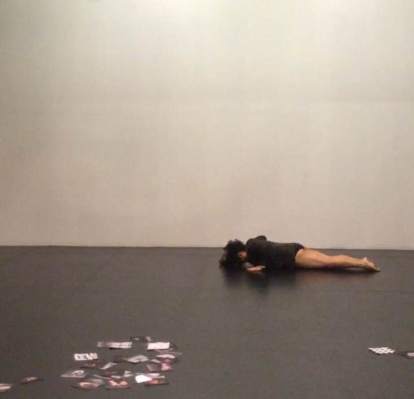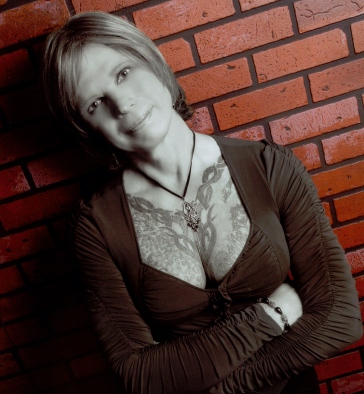
Who are you and what is your show called?I’m Syniva Whitney, the choreographer, director and writer…and also one of the members of Gender Tender. Our piece in Q-STAGE is called “BENT/STRAIGHT” – performing this weekend, May 20 & 21 at 7:30pm, and Sunday, May 22 at 2pm.As one of our 2016 Q-STAGE Artists, can you tell us about where the idea(s) for your show came from?
Well, I guess I jumped down the rabbit hole of BENT/STRAIGHT by creating fictitious versions of my co-star Will Courtney and I. They’re names are Wizard and Scout. This work has developed into its own world mixing up my interests as a dancer, a visual artist and a drag performer as well as my a love for film noir and futuristic thinking. The imaginary couple Wizard and Scout are always wrestling with the anxiety of losing their better half while also wondering who is the better half and wondering if thinking there IS a better half does that mean there’s an evil half? Or maybe there is never a whole. A whole what? They’re not sure.
This work is also certainly about navigating the world in as a non-binary person…the weirdness that happens as a so very bent person walking through a mostly straight world…that feeling of the black hole of the straight world taking up so much of your tiny island of queer space with all the barbed wire and booby traps around it but somehow something still gets in, threatening ourselves and our loved ones, seeping into our minds and souls. That sense of being outnumbered, tokenized, invisible, misunderstood…and then finding a loved one, another flame in the dark. It’s an abstract work, at times super visual and very physical. Using abstraction and movement as language to me means honoring what we cannot explain, name or define, we’ve got to experience it to know. This is also inspired by the fact that Will and I are a real life queer couple, an alternate spin off, bizarro us. There is also compulsive urge I have to modify or mutate my own world, my home, my own body for good and bad reasons….also the urge I have to fulfill the desires of others, build their dream worlds and dream bodies. This is probably present in BENT/STRAIGHT. I think we are all wizards with the power to create change inside and outside of ourselves….I also think we are all scouts testing the terrain and preparing others for what is to come.
Have you been collaborating with any other artists to create this show? Who are they and how are they contributing?
We’ve been collaborating with visual artist Madeleine Bailey. She’s a very good friend of mine, and we met while in the MFA program together at the School of the Art Institute of Chicago. She’s a multi-disciplinary artist, writer and mentor currently based in New York…she’s been coming here to Minneapolis for a few intensives and collaborating digitally and on the phone from the beginning of this project talking visual stuff, brainstorming and testing ideas for BENT/STRAIGHT. She’s got big beautiful ideas and I’m so inspired by that, I love what she’s created for this work. Making the objects come to life has added a whole other dimension to the process and it’s been a lovely mind meld. Madeleine is also a fellow lover of film noir and the absurd and so we’ve had fun doing research and just getting deep into playing around with what could happen….she’s brought an amazing eye to this, I feel lucky she agreed to work with us! We get to perform with her objects throughout and there is also a light installation that we interact with and kind of build during this performance. These elements have really become a part of the heart of this work. Also, we’ve got music from Ariskany Records featured throughout. Ariskany Records aka Cary and Evan James. They are brothers and artistic collaborators and we’ve been able to use their music in a lot of our work in the past and I’m so happy they still don’t mind us using their art as a soundtrack for Gender Tender. I’m a big fan, I love the sound they create and definitely have always felt aligned with their experimental approach to making music. Check them out! Download it, you’ll like it. I love being able to dance to their sound, it makes me so glad I get to do this kind of work. And of course Will Courtney is a brilliant performer and lovely human and it’s been an amazing experience having so much time to develop the work together. Collaboration is the best.
Are you working on any other projects or are there others you hope to work on?
Yes, I was invited by Pramila Vasudevan to be one of the facilitators and designers for Aniccha Arts upcoming durational performance called Census. It will be happening at Northern Spark this June. Will is performing in it as well. It’s been great to work with a big team of artists of all disciplines and backgrounds since this past December talking about social identity mapping, institutional structures, parades, autonomy, underrepresented communities, the idea of a critical mass and people performing murmurations. There will be a cast of a 100 people performing in a line for 9 hours! So excited to be a part of this project.
As far as Gender Tender and my own personal projects…I’m always looking forward to making new or more work, or getting to refine and research what we’ve got….I have a recent dream of writing and directing a solo work for Will, so we shall see. I keep writing. I’m always looking forward to continuing to create new things, to keep on art-ing.
What is your favorite hangout spot and why?
Currently and usually my yoga mat in the morning is a favorite spot…especially with some sunshine coming in the window. Yeah, also I like going outside and staring at trees and sky and birds and people and squirrels lots of squirrels in Loring Park. Also, I like sleeping in. I’m cool like that.
When you’re not deep in Q-STAGE rehearsal and development, how do you spend your time?
I’m into watching cooking shows on Netflix… especially demented ones like Cutthroat Kitchen and Chopped. I think these kinds of things should definitely replace fighting of all kinds in general. Let’s just have a cook off. Someone can win. And then we can all be friends and eat together.
Don’t miss BENT/STRAIGHT this weekend! Click here for info & tickets.



